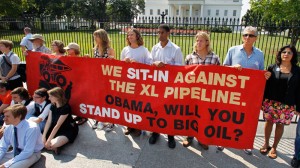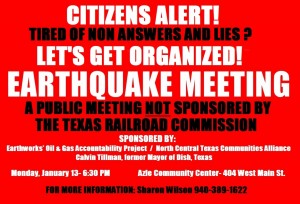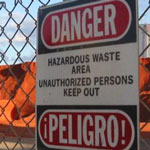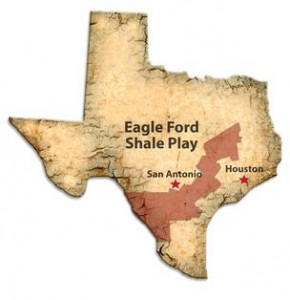Uncategorized
Either Way, is Keystone Decision Really “Game Over?”
 There's no doubt the anti-Keystone effort is the most successful climate change campaign the country has ever seen. Thousands have turned out for marches and candlelight vigils, it's sparked civil disobedience from the White House to East Texas, and created more political pressure for the President than any other single environmental issue.
There's no doubt the anti-Keystone effort is the most successful climate change campaign the country has ever seen. Thousands have turned out for marches and candlelight vigils, it's sparked civil disobedience from the White House to East Texas, and created more political pressure for the President than any other single environmental issue.
That said, was it the right campaign aimed at the wrong target? Former NASA scientist's James Hensen's dire warning that it was "game over" if the pipeline got approved is an ultimatum that leaves the movement that it built no place to go once the decision is made. And with the opening of the southern section of the pipeline through Texas this past month, the hand-wringing over the State Department's luke-warm approval, and President Obama's final decision to support or oppose seems very anti-climatic.
The Houston Chronicle's Jennifer A. Dlouhy looks at the debate within the environmental movement over whether it was wise to put so much emphasis on a single project in this Fuel Fix article.
Opponents say the proposed $5.4 billion pipeline would be a catalyst to unlocking oil sands development in Alberta, Canada, where a dense, sticky hydrocarbon called bitumen is harvested by strip-mining and energy-intense steam-based techniques.
Environmentalists view the decision on whether to permit the border-crossing pipeline as a test of President Barack Obama’s green credentials and a symbol representing much deeper, more complicated climate-change questions.
Sarah Ladislaw, energy program director at the Center for Strategic and International Studies, said Keystone XL has become “a litmus test for where the country stands on a low-carbon pathway.”“But my question is, what do you do after Keystone?” Ladislaw said. “Yes or no, it is not the last pipeline that will get permitted.”
Meanwhile, writing in "Yes" Rockefeller Brothers Fund Michael Northrop gives eight reasons why there's still hope no matter what the President decides, although some (transportation going electric, more renewables) sound more reassuring than others (cities and states taking action).
Both of these pieces basically ask and try to answer the same question. A lot of money and infrastructure has been spent trying to define climate change with a single project. What happens to all of that once the Keystone decision is history?
No Joke: A Kid, Elvis, and a Rocket Scientist Walk into a Railroad Commission Meeting……
 This is a picture of Robert Caney. Despite achieving the advanced age of 11, he was the youngest member of Tuesday's frakequake bus contingent to the Railroad Commission meeting in Austin.
This is a picture of Robert Caney. Despite achieving the advanced age of 11, he was the youngest member of Tuesday's frakequake bus contingent to the Railroad Commission meeting in Austin.
Robert lives about four miles from the epicenter of the "swarm" of earthquakes that have plagued the residents who live along the convergence of the Parker, Tarrant and Wise county lines northwest of Fort Worth.
You've probably not met many 11-year olds like Robert. He brings new meaning to the word precocious. Without a doubt, he was one of the most articulate people in a RRC meeting room that was packed full of articulate storytellers on Tuesday. And he was also among the most direct among a crowd that doesn't mince its words.
"I have to say that the operations of these wells have to stop now," he lectured RCC Chair (and State Attorney General candidate) Barry Smitherman, and the other two Commissioners. "I want to know how you're going to solve this problem." The kid is alright.
Of course, Robert was media bait, but he had some strong competition in that category. There was Big Bill Hoffman, the Singing Quaker who re-wrote the lyrics to "All Shook Up" and accompanied himself on guitar – in the bus going down to fire up the troops, outside the meeting for the press, and even for his testimony in front of the Commission. Sources believe it to be first such instance of public testimony being sung in the Commission's 123 year history.
Then there was the unintentional comedy team of Stokes and Wood.
Reno (pop 2546) Mayor Lynda Stokes was the first speaker on behalf of the group and she went through the long litany of scientific, well-documented connections between injection wells and induced "earthquakes" that everyone at the Railroad Commission seems to want to not to admit exists. At the end she totaled up the evidence and made the common refrain that "It doesn't take a rocket scientist to see there's a link" between local injection wells and the 30-something quakes the area has experienced since November.
Several speakers later, up pops one Gail Wood, who it turns out IS a former NASA rocket scientist, and states unequivocally that, yep, you really don't have to be one to get this stuff. He brought down the house.
It was the political equivalent of the scene in Annie Hall when Woody Allen, while disputing a fine point of media theorist Marshall McCluen with a friend, is able to conjure up the real-life McCluen out of nowhere to bolster his argument. "You don't need a rocket scientist to know there's a connection. And to prove it, here is one."
Surrounding these speakers were lots and lots of the very kind of folks who probably voted a straight Republican ticket in the last election. The very kind of people that Smitherman is counting on to propel him into higher office. The very kind of people that Milton Rister, Governor Rick Perry's "ideological hit man" who's been imbedded at the RRC as Executive Director, usually counts on to beat back all those treehugging, industry-hating greenies. Only this time they were ones complaining about putting profits before people!
With bolo ties, western shirts, and Stetsons costuming the rhetoric, in many ways it was if Occupy Amarillo had shown up.
And therein lies the problem for the current Administration. These are not the usual suspects that can be dismissed for their ties to "kooky far-out" groups like Environmental Defense Fund and the World Wildlife Federation. These folks are their license-to-carry constituency.
So instead, the RRC has decide that there's just a big mystery here that, by gosh, we just can't seem to solve without more time to study this problem. Smitherman had a go at justifying the agency's inaction by saying the volumes pumped into the two wells closest to the epicenter of the quakes had decreased in the last couple of years – as if the previous years of high-volume pumping had never taken place. If your filling up underground spaces that you didn't know were there and don't know anything much about, hard to say what the tipping point is for setting off, eh Chairman?
But he also left some wiggle room about "faults we didn't know about" that, somehow geology textbooks seem to have discovered. We're making the bold prediction that the seriousness of these "new faults" at the RRC will be directly proportional to the hell that citizens can continue to raise going onto this next election cycle.
in the end, the whole day was an opening shot. By citizens, who invaded the RRC's home turf and had a successful media field day for their cause that keeps up the pressure, and by a desperate RRC shotgunning a load of responses, hoping one or more might be able to hit a target. Protocol was observed. Everyone was more or less polite. There were no citizens thrown out of the meeting this time, No unruly mobs. Yet. Stay tuned.
Media coverage:
“It’s impossible to know with no information what level is safe.”
 Some of the very best reporting about the underlying problem that's responsible for the West Virginia water crisis is being done by the local Charleston Gazette.
Some of the very best reporting about the underlying problem that's responsible for the West Virginia water crisis is being done by the local Charleston Gazette.
Following up on their great piece revealing that "MCHM" has exactly one un-reviewed, unpublished 1990 study performed by the chemical manufacturer to say that it's safe to use in the marketplace, on Friday the paper looked closer at the lack of human health effects protocols for chemicals used in the US as a whole.
"They did the best they could with very limited information," said Glenys Webster, an epidemiologist and postdoctoral fellow at Simon Fraser University.
But, Webster said, the entire system the U.S. uses to study and regulate toxic chemicals left decision-makers in West Virginia with a huge vacuum of data and analysis they really needed.
'It's impossible to know with no information what level is safe," Webster said. "I don't think we have the information to make a decision that will satisfy the public."
The paper also quotes toxicologists who explain why the Center for Disease Control's "safe" exposure level for MCHM, which is now being used to give the OK to resume use of Elk River water in Charleston, actually results in the most vulnerable sub-populations, infants and young children, ingesting "closer to that maximum level considered safe by the CDC."
The experts noted that the CDC calculation contained a wide variety of uncertainties that could mean the actual "safe" level is far different from what the agency estimated.
"I think the CDC tripped up when they delayed before issuing the pregnant woman warning," said Jennifer Sass, senior scientist with the Natural Resources Defense Council. "I would recommend that not only pregnant women, but also infants and children avoid the water as long as the chemical contaminants are detected. And, the public needs to know what the detection limit is, so an informed decision can be made about how long to wait after the chemicals are no longer detected."
Experts pointed to a variety of weaknesses in the CDC's approach. Most importantly, they said, it was based on little data. Also, rat studies based on high doses of chemicals can often mask adverse health effects that occur at lower levels.
"It's a very rough calculation," Webster said. "And each step has uncertainty associated with it. It is not an exact science."
Truer words were never spoken. Which is, in part, why 200 people will be going to the Dallas premiere of filmmaker Ed Brown's "Unacceptable Limits" on the evening of January 30th at the AMC 16 at Valley View. There were only 31 seats left as of Sunday afternoon. There's also a panel discussion at the end of the film that includes Downwinders' Jim Schermbeck, along with fracking activist Sharon Wilson, and Texas Campaign for the Environment's Zac Trahan. So please stop by the film's website and buy a ticket for $11.00 to go see a film demonstrating why, whether you live in Irving, Texas or Charleston, West Virginia, you're being chemically assaulted by the same obsolete regulatory system.
Why W. Virginia Crisis Is Perfect Example of Our Lab Rat Status Quo – “Unacceptable Limits” Premier Moves to Larger Theater
 Just to make sure you got the message of Ed Brown's new film about how FUBAR'd the chemical regulatory system is in the US, the twice-convicted felon who runs Freedom Industries in West Virginia arranged for tens of thousands of gallons of a little-known, little understood synthetic substance to spill into the Elk River, cutting off drinking water to 300,000 Charleston area residents.
Just to make sure you got the message of Ed Brown's new film about how FUBAR'd the chemical regulatory system is in the US, the twice-convicted felon who runs Freedom Industries in West Virginia arranged for tens of thousands of gallons of a little-known, little understood synthetic substance to spill into the Elk River, cutting off drinking water to 300,000 Charleston area residents.
So don't let this contamination go to waste – get thee to the online ticket booth and grab some stubs to the January 30th Dallas premiere of "Unacceptable Limits" before it sells out again. They moved it to a bigger theater inside the AMC 16 complex and there are another 50-70 seats now available. The film's producer is showing up and they'll be a short panel discussion afterwards involving Sharon Wilson of Earthworks, Zac Trahan of Texas Campaign for the Environment and Jim Schermbeck of Downwinders at Risk.
And if you read nothing else about the West Virginia situation, please take five minutes to scan this excellent account by the local Charleston Gazette, of how officials are pulling estimates of "safe levels" of the substance MCHM out of their regulatory asses. Why? Because it takes the story away from the god-awful specifics of West Virginia and applies it across the board to explain how no one – not industry, not the US government, not scientists of any sort – has any idea what's a safe exposure to most of the 80,000 chemicals we're coming into contact with in the marketplace. This is exactly Mr. Brown's point in "Unacceptable Limits," and the West Virginia story makes it in spades…..
Tierney explained that the CDC looked for relevant studies of the chemical's health effects but found only one — a 1990 study by Eastman, maker of the product, that was not published in peer-reviewed literature and is considered proprietary.
That study, she said, was the basis for the median lethal dose, or LD50, listed on an Eastman "material safety data sheet," or MSDS that's been circulated by local emergency responders, health officials and the media.
And there you have it. We have one study about the health effects of this chemical. It was done in 1990 – which in environmental health data years, is like the mid-1800's. And it was done by the entity hoping to make a profit from its manufacture. Nothing unseemly there! And then of course we're only talking about fatal doses...
(Based) On that MSDS, the LD50 for Crude MCHM is listed as 825 milligrams per kilogram. This means that, when tested on rats, an 825 milligram dose per kilogram of body weight was enough to kill half the rats.
"The experts then took this number and calculated the uncertainty factors," she wrote. "In this situation there were two. The first uncertainty factor was translating these results from rats to humans. The second uncertainty factor took into account sensitive populations. This includes the elderly, the sick, the immuno-compromised and children, amongst others.
"Uncertainty factors range from 5 to 10 percent," she wrote. "Given the dearth of data and an abundance of caution, both uncertainty factors were rated at 10 percent."
This, Tierney explained, changed the level that would cause death to 8.25 milligrams per kilogram of body weight.
LD50 figures, though, consider only death. They would tell officials nothing about what levels at which chemical exposure would cause other health effects, even serious ones.
To address this, they changed the figure to 1 milligram per kilogram of body weight, which is equal to 1 part per million. It's not clear though — and Tierney did not explain — the scientific basis for the change from 8.25 milligrams per kilogram to 1 milligram per kilogram.
"In this case, it is the entire toxicity profile of a chemical that is unknown. However, predictions are based on what we do know looking at the chemistry and the available data," she said. "In this case, we are dealing with a short-term exposure as opposed to situations in which people have been exposed for weeks to months to years."
Well, at least as far as we know now. The tanks storing the chemical could have been leaking for a long time before they ruptured. The water supply system in Charleston isn't built to catch and filter this kind of chemical, so we'd never know except for a catastrophic accident. In all kinds of ways, we're no different than the rats in the Eastman experiment. No doubt, the catastrophe in Cahrleston will be an epidemiological field day of new research on the health effects of MCHM.
You could throw a dart at nearly all of those 80,000 chemicals on the marketplace and find a similar lack of hard data supporting their benign effect on human health. This is just a more spectacular and acute example.
You might rightly assume that the EPA or FDA or some government agency somewhere is testing these chemicals to make sure they'll be safe when they get rubbed on skin, or inhaled in a lung, or swallowed down a gullet. There is no such agency. No such testing takes place on these chemicals individually, much less in combination with one another, as they would be expected to be experienced in the real world. When there is a study, it is, more often than not, done by the company who wants to make a buck selling the chemical. And even then, the result is limited to finding a less than lethal dose, not understanding how the chemical might disrupt hormones, or the immune system, or have other, more subtle effects we have only come to know about in the last 5-10 years.
Do yourself a favor and get tickets to the January 30th showing of "Unacceptable Risks." Bring your neighbor. Before you find out more than you want to know about the next contaminant gone astray.
Because How Can You Go Wrong When Nature Is Your PR Agent?
 Second Azle quake in two days prior to tonight's meeting.
Second Azle quake in two days prior to tonight's meeting.
Seeing Progress On $84 A Day
 Like What We Just Accomplished in Dallas? Please Help Us Keep Doing Good Work. Donate Before January 1. Thanks.
Like What We Just Accomplished in Dallas? Please Help Us Keep Doing Good Work. Donate Before January 1. Thanks.
"One of the toughest gas-drilling ordinances, not just in the Barnett Shale, but in the nation." That's what the media has been saying about the new Dallas gas drilling ordinance that residents won last Wednesday at City Hall.
Thanks to everyone who ever came out to a Planning Commission or City Council meeting or hearing. Thanks to those who provided a spectrum of heart-felt testimony. Thanks to those who sent e-mails when we asked you to, wrote letters and made phone calls. Thanks for hanging tough with us through the long slog of Trinity East battles, followed by the laborious job of actually writing a new ordinance – all within a system that was rigged against us. Showing up makes a difference.
Do-It-Yourself Democracy is messy and time-consuming. We hope you think the final results were worth it. We do. Combined with the Trinity East permit denials, we think this ordinance was one the most effective counter-strikes against a powerful Barnett Shale Gas Lobby in years. it had the additional advantages of giving local environmentalists political muscle in Dallas politics they haven't had before, and giving hope to others fighting for more protection from gas facilities elsewhere. We've gotten thank-yous and inquires from across the country.
The Dallas gas ordinance is just the latest and best example of the Downwinders at Risk philosophy of using local fights to set national precedents. Stick around, stand your ground, and lead by example. Or as some Greek guy named Archimedes once said, “Give me a place to stand and I will move the world.” What residents accomplished at Dallas City Hall last week moved the world.
We don't have to be beholden to Austin or Washington for "change" to trickle down from those capitals. We can make serious grassroots social change right here in the Belly of the Beast that has a national impact. It doesn't happen by accident, or just because we have a righteous cause. It happens because of years of planning and intense campaigning. Of constantly showing up, doing the research, attending the meetings, making the appointments, getting things done.
While this last Wednesday's win was a group effort, there's no doubt that Downwinders at Risk provided the leadership, the strategy, and the experience to mold the movement in Dallas into an effective policy-making juggernaut that it had not been elsewhere in North Texas. It's not a coincidence that this breakthrough came in Big D. Three years ago Downwinders said we were drawing a line in the Shale in Dallas and fighting back against an industry that thought it had a blank check to do just about anything it wanted. Along with the defeat of the Trinity East permits earlier in the year, we think the new Dallas ordinance delivers on that goal.
Since Downwinders at Risk decided in 2011 to expand its mission to protect the entire DFW airshed from toxic air pollution, all we've done is shut down a outlaw lead smelter, stop a wave of new park and floodplain drilling, and pass one of the most protective gas ordinances in the country. What other group do you know of that could turn on a dime and win on all those local fronts – or has the resources or motivation to do so?
We think we've done a good job of proving the same organizing strategy that cleaned-up the Midlothian cement industry can be applied effectively to other important threats to public health.
That strategy starts with paying at least one full time professional staff person to represent citizen interests in clean air fights and work on their behalf. Industry has armies of consultants and lawyers. Government as well. Citizens come to fights like the Dallas Gas Wars with no such pool of expertise. If your group or cause can't afford to hire a lawyer and other specialists, then you're very much alone. Until you call Downwinders at Risk. And then, for no charge at all, you get hours and hours of relentless effort that may, with some luck, change your life and the world.
We offer this service to all comers on a organizational budget that measures out to about $84 a day.
That amount of money can't buy you much. Larger environmental groups could spend that on copy toner alone. But when Downwinders' spends it, it can buy you 4000 pounds less lead every year in the air you breathe, or a lot fewer gas wells next to your neighborhood.
In 2014, Downwinders at Risk will be 20 years old. We have no idea how we'll change history in the next 12 months, but we do know that we will change it, because we'll keep showing up trying to change it. And persistence is very much part of our success.
We're going to follow-up the Dallas ordinance with the passage of the nation's first local air pollution off-set rule that can plug the loophole the gas industry uses now to escape Clean Air Act requirements to balance their impacts in smoggy areas. We're going to think about whether we can deploy the same coalition model that worked so well in Dallas deeper into the Shale. We're going to keep trying to prevent the City of Frisco from building a permanent toxic waste landfill in the middle of town. We're going to be trying to use a new DFW clean air plan to get new pollution controls for cement plants, coal plants, the gas industry and other large sources.
We're 100% local. Our board all lives here in DFW. Our entire mission is devoted to making air cleaner in DFW. We're completely dependent on local sources of funding. That means people like you. If you don't support us, then we can't pay our staff person to show up. And when he doesn't show up, the system isn't nearly as citizen-friendly.
We think this last year's worth of headlines from the Dallas Gas Wars and the Frisco lead landfill fight is our best case for asking for your tax-deductible donation before the calendar year ends. We need your help to keep making those kind of headlines. We promise to do our part. Please consider a contribution to Downwinders of at least $84 to sponsor a day's worth of DFW clean air organizing. All you have to do is fill out the secure online form by clicking here. We not only really appreciate your support, we can honestly say we can't do our work without it. Thanks.
It’s Official! Frisco City Hall Wants to Open the Town’s First Toxic Waste Dump
 Yesterday, Frisco Unleaded announced it was launching a community clean-up campaign to spotlight the city's indecision about submitting a claim to bankruptcy court covering the entire bill for a complete clean-up of the Exide site. We're having our first event on the Square, Saturday, November 9th.
Yesterday, Frisco Unleaded announced it was launching a community clean-up campaign to spotlight the city's indecision about submitting a claim to bankruptcy court covering the entire bill for a complete clean-up of the Exide site. We're having our first event on the Square, Saturday, November 9th.
In response to reporter's inquires about our objections, the Austin-based "environmental attorney" the city has hired finally admitted what the Mayor and Council have been afraid to say out loud to its own residents at the last two council meetings – that the City is poised to approve the siting of a new permanent toxic waste dump in Central Frisco to bury the Exide waste instead of a complete clean-up.
The reason for this decision? Because it's better to have the waste buried in Frisco, next to people, schools and parks, than to transport it to a more isolated licensed landfill designed for the disposal of hazardous waste.
Think we're joking? Go read the article yourself. This is what the City is saying:
"I strongly believe the city is in a much better position to control its liability and protect the public by maintaining control of that waste in the long term right here with the proper remediation and containment mechanism than it would be to haul it to Oklahoma or Colorado orto some other hazardous waste landfill where it's then mixed with everybody else's waste and you become liable for everythingat that site."
We hardly know where to start in replying to this absurd argument, but let's try. with our own….
TOP TEN REASONS
WHY THE CITY'S DUMP PLAN IS A BAD IDEA
10. You admit there's substantial liability in disposing of Exide's waste. But you're willing to impose that liability on your own residents here in Frisco, at a location never designed to be a toxic dump that's near neighborhoods, schools and parks, rather than transferring that liability to a more isolated location outside of Frisco designed for the job of burying hazardous waste. Thanks so much for caring.
9. And you're relying on Exide, the state, and EPA to monitor and maintain this new toxic dump site for the rest of eternity? Just like they did for the site the first time around as a smelter? What could possibly go wrong?
8. Apparently you've only looked at the costs of 30 years of monitoring and maintenance at this new toxic dump. Why stop at 30? It doesn't get any less toxic with time. This thing is permanent.
7. You say you're very concerned about the liability. What's the liability for a catastrophic accident that sees toxic lead waste pouring into Stewart Creek going through Grand Park and residential neighborhoods along the way to Lake Lewisville?
6. Will the landfill meet all the modern EPA requirements, or will they have to be exempted from some because of their location and circumstance? In other words, are you building a state-of-the-art facility, or something less? Ah, you don't know.
5. Has the City performed some kind of secret risk assessment regarding the hazards of building a new toxic waste landfill for Exide's waste in Frisco vs. disposing of it in a licensed landfill that's already built? We didn't think so.
4. So your attorney says the City of Frisco ALREADY has equally liability regarding the waste at Exide. How exactly is that going to affect the City's financial obligations?
3. Has the city compared the cost of decreased property values and property taxes that a toxic landfill would create vs. the economic benefits of a complete clean-up of the Exide site? And you call yourselves Republicans?
2. Can you point to any city, especially one of Frisco's caliber, that has actively recruited a hazardous waste landfill to feature in its city center, upstream of it's biggest park? We'll wait for an answer.
1. If burying lead waste in place isn't such a big deal, why didn't Dallas seek that kind of solution in West Dallas with its numerous piles of battery chips and slag? Instead, they dug it up and hauled it out.
So….West Dallas got a better clean-up than Frisco is going to get? Interesting twist.
What You Can Do:
3. Come to our Community Clean-Up on the Square on Saturday November 9th from 10 am to 2 pm where you can get free lead testing, educate yourself about this situation, pick up bumper stickers, sign postcards to the Council, and show your support for a complete clean-up instead of a toxic dump.
4. Use our new website devoted to this dump issue – www.nofriscodump.com and our Facebook page to keep in touch with the latest developments.
5. Get more involved. We know you thought this was over when the smelter closed. But it's not. Don't let the city council create another disaster at the Exide site. Only Frisco residents can stop this dump.
City’s Indecision Over Exide Clean-up Spurs Frisco Residents to Do it Themselves

Community Clean-up Begins November 9th with Free Lead Testing on the Square and a Sweep of Grand Park Contamination
For Immediate Release: 9 am, Tuesday, October 29th, 2013
(Frisco)— Frustrated that city officials are wavering between a permanent toxic landfill and a complete clean-up of the notorious Exide lead smelter site, Frisco residents on Tuesday announced their own do-it-yourself effort to prevent what they say is a second disaster in the making.
"At the exact time the City needs a bold and optimistic vision for this huge piece of Central Frisco, our officials seem to be willing to accept the equivalent of a Superfund Site between the new Cowboys headquarters and Toyota Stadium," said Equilla Harper of Frisco Unleaded, the group widely credited with hastening the smelter's demise in 2011.
On Saturday November 9th from 10 am to 2 pm , Harper and other members of her group will be set up in Frisco's main square offering residents free access to an XRF lead analyzer and a trained technician for testing objects such as soil from suspected contaminated Exide lead waste hot spots in town, household objects that residents might suspect contain lead like paint chips, pottery, backpacks, and jewelry, and whatever else they want to bring. No blood or bone testing will be offered, but information on how to get such testing will be available.
They'll also be sending out small teams of investigators to sweep the city's own 300-acre Grand Park property that sits directly downstream of Exide and has already been confirmed by authorities as a contaminated area. Members will flag and collect suspected battery chips and pieces of lead "slag."
It's all part of the group's "community clean-up campaign" meant to put City Hall in the hot seat on the eve of a decision about the Exide property that the residents say could determine the fate of the city's core for decades.
Frisco, along with other cities across the country that believe their communities have been damaged by Exide facilities, must submit a monetary claim by December 9th to the judge hearing the company's bankruptcy hearing. Currently, the city is asking for approximately $20 million. That's only enough to build a new toxic waste landfill on the smelter site, beside Stewart Creek and upstream of the city's Grand Park.
But according to the city's own engineering consultant, it's going to take $135 million to dig up the lead waste, haul it out and make the property and Stewart Creek safe for redevelopment. Frisco Unleaded wants the city to ask the court for this larger amount for a complete clean-up, and they don't know why Frisco officials are hesitating.
"Nobody expects the bankruptcy court to give you everything you ask for. But to get the most money you can, you have to ask for the most, not the least. You don't have to work on Wall Street to know that," said Harper.
So far, the city has remained tight lipped about what it plans to do, refusing to discuss the pros and cons in public. Frisco Unleaded's campaign is meant to bring that debate out in the open.
It's a debate the group thinks it can win if Frisco residents are aware what's at stake. For example, members are arming themselves with information about how much toxic waste landfills can damage property values.
"There probably aren't a lot of people in Jerry Jones' Starwood development just down the street from Exide that realize the Council's decision about Exide could significantly affect their home's re-sale value. There's evidence these landfills can negatively impact property up to five miles away" said Jim Schermbeck of Downwinders at Risk, the 20-year old clean air group that sponsored Frisco Unleaded's start-up.
There's also the fact that the landfill would pose a constant threat of catastrophic failure to Stewart Creek and Grand Park for the entirety of its existence, as well as the more routine danger of leaks and discharges.
"Grand Park will never be Grand as long as there's tens of thousands of tons of toxic lead waste buried upstream, right beside the banks of Stewart Creek," said Meghan Green, a resident who's been involved with the issue for over three years. "We already have parents telling us they'll never use the park as long as that waste remains. That just isn't right and the city needs to realize it's in its best interest for its own citizens to be able to enjoy their own parks without fear of being poisoned."
In the last month, a representative of the group has appeared before the City Council twice to request that they submit the larger figure to the bankruptcy court and declare their public support for a comprehensive clean-up instead of the landfill option. Last week a member received a commitment from Frisco State Representative Pat Fallon to draft a new piece of state legislation that would divert more state battery fee money to cover the costs of a complete clean-up of Exide.
Green and Harper are clearly frustrated that the city isn't being more vocal about what needs to happen with the property. "We're working as private citizens to try and put together a package with enough money to pay for a real clean-up," said Harper. "We don't see the city getting out front and doing the same thing. They need to show leadership and commit to cleaning-up and developing the site so there's no trace of the Exide smelter left. Anything else allows Exide to keep threatening our community."
Cement Plants and Gas Plays Affecting Ozone Levels In….San Antonio?
 For decades DFW was the only major urban area in Texas to have its air quality challenged by the cement industry. Repeated modeling over the course of the last several local air plans showed that the concentration of the plumes from three huge cement plants in Midlothian could increase downwind ozone levels significantly. Part of this is the voluminous emissions produced by the kilns and part of it's location, location, location – the close proximity of these cement plants to the center of DFW. So much so that you can see their smokestacks from I-20 in Grand Prairie and Arlington.
For decades DFW was the only major urban area in Texas to have its air quality challenged by the cement industry. Repeated modeling over the course of the last several local air plans showed that the concentration of the plumes from three huge cement plants in Midlothian could increase downwind ozone levels significantly. Part of this is the voluminous emissions produced by the kilns and part of it's location, location, location – the close proximity of these cement plants to the center of DFW. So much so that you can see their smokestacks from I-20 in Grand Prairie and Arlington.
Then beginning in 2006 or so, the area's air shed began to be reshaped by the presence of gas production facilities as the Barnett Shale was opened up to exploitation from fracking, a process freshly exempted from just about every federal environmental regulation with passage of the 2005 Energy Act. But unlike large "stationary sources" like cement plants, these gas facilities were spread out over a large area, right in the middle of the Metromess, and were except from the "off-set" requirements of other large polluters. Even though their collective emissions were as large or larger than any other single industrial source, their decentralization allowed their operators to release their tons of pollution into the air without ever having to consider its impact on local smog levels.
That one-two punch of local industrial pollution flies in the face of the office park business image of DFW. Houston has traditionally been the city where industry has made it harder to breathe. In North Texas, it's supposed to be all about cars and trucks. But those cars and trucks lay a mostly uniform blanket of ozone over the entire area, whereas the gas production facilities and the cement plants are concentrated fire hoses of smog-forming pollution that can impact specific monitors over and over again.
And all of this has taken place during a time when the official federal ozone standard has been a relatively high 85 parts per billion. Beginning in 2015, the standard becomes 75 ppb, and it might drop to 65-70 by 2020.
Texas cities like Austin and San Antonio have had little problem complying with the higher standard, but now face obstacles to coming in under the wire of a 75 ppb rule.
For one thing, the only other large concentration of cement plants in Texas besides Midlothian is located along the I-35 corridor from Buda, south of Austin to North San Antonio. Because prevailing winds have often carried the pollution from these plants away from central Austin or San Antonio, they haven't been seen as much of a threat. But now urbanization is increasingly creeping westward into the downwind path of these plumes, adding some heft to the emissions and combining with them to elevate ozone levels.
And then there's the Eagle Ford Shale gas play, the new Wild West of fracking in Texas, taking place directly upwind of central San Antonio. Unlike the urban drilling in the Barnett Shale, most of the activity in the Eagle Ford is taking place in unincorporated parts of South Texas counties. There haven't been any reliable emissions inventory of the pollution coming out of he Eagle Ford, but it's considerable. Anecdotally, there seems to be a lot of flaring that DFW never saw. Because of the amount of production taking place, as well as its location upwind during the summer "Ozone Season," Central Texas is starting to sweat about its impact on its own air quality.
That concern has prompted a regional modeling exercise which is supposed to determine how much, if any, impact the drilling in the Eagle Ford is having on the Alamo City's air. Back in July, we reported that the preliminary numbers of this study showed that gas production was capable raising local ozone levels by as much as 3 to 7 parts per billion by 2018 – exactly when all Texas cities must be in compliance with the new 75 ppb standard.
Maybe 3-7 ppb doesn't seem like much. And it isn't, unless you're already at or above the new 75 ppb standard and that amount will put and keep you over that red line. Like San Antonio in 2013. The July headline in the San Antonio paper was unambiguous: "Eagle Ford drilling is polluting San Antonio's air"
But it looks like someone at the San Antonio Council of Governments is taking a page from DFW and TCEQ officials and downplaying those preliminary numbers from last summer.
Previous studies show that emissions of ozone-forming chemicals from sources other than drilling have dropped significantly since 2007 despite the city's population growth, said Steven Smeltzer, AACOG's environmental manager. Smeltzer attributes the improvement to new vehicle standards and voluntary reductions by local industries.
Preliminary numbers from the AACOG study also indicate that much of the problem lies in the Eagle Ford. InsideClimate News obtained a copy of the data, which have not been made public. The data show that during the months when San Antonio experiences the highest ozone levels—April through October—oil and gas development produced about half the amount of ozone-forming emissions per day as all other industrial sources combined.
Bella said the data came from an early version of the study that wasn't as thorough as later drafts. "My sense is they're really not worth using…They're not solid numbers."
He declined to comment on whether the numbers are close to the latest estimates. What matters isn't the number, he said, but the process behind the study. If the science isn't right, then it's "garbage in, garbage out."
Yeah, we know. Believe it or not, citizens had to literally force the TCEQ to consider the effect of the pollution from Midlothian cement plants before they discovered, wow, they really do have an impact. Likewise, it took Dr. Al Armendariz's 2009 study of Barnett Shale pollution for the state to even consider local gas sources might be a contributing factor to the DFW smog problem – although TCEQ officials are still doing their best to deny it. The largest purveyor of junk science in Texas is the Texas Commission on Environmental Quality. Remember that in 2012, TCEQ's computer model told us to expect the lowest level of smog ever recorded in DFW. Instead we got the highest levels recorded since 2008 or so. So yeah, GIGO.
That's why it's disappointing to see the Council of Government official try to use the same strategy with this new study – whose final edits will be made by TCEQ, not an independent entity. Just like with TCEQ's Wednesday's ruling against 7000 Dallas County doctors that said there's no link between smog and public health, Rick Perry's agency can't afford to admit the state's gas plays are making the state's air illegal and unsafe.
Like San Antonio, almost every other category of pollution in DFW has decreased over the last 6 years – except gas industry pollution. It's the one category of emissions that's grown and grown and grown – to the point where the state itself admitted that the industry was releasing more smog-forming Volatile Organic Compounds than all the trucks and cars on the road in North Texas. As DFW continues to linger in violation of an almost 20-year old obsolete ozone standard, it's the gas industry that is the logical culprit for the backsliding. It's the one variable that's going the opposite direction as all the others. But despite the overwhelming evidence to the contary TCEQ is busy defending the Shale from any charges that it has the least bit of impact on area smog, even to the point of ignoring basic air modeling chemistry.
San Antonio officials may want to deny the link between the Eagle Ford and smog in their city, may want to down play it, and they'll have plenty of rhetorical help from Austin. But when it comes to TCEQ rhetoric versus the real world, the monitors in the field tell the tale. Negligence doesn't make your air cleaner.
Climate Change as Human Health Issue
 Overlooked in the local press was a late September study from the University of North Carolina that correlated reductions in greenhouse gas (GHG) emissions with decreases in worldwide air pollution deaths. "It's pretty striking that you can make an argument purely on health grounds to control climate change," one author told the British Guardian newspaper.
Overlooked in the local press was a late September study from the University of North Carolina that correlated reductions in greenhouse gas (GHG) emissions with decreases in worldwide air pollution deaths. "It's pretty striking that you can make an argument purely on health grounds to control climate change," one author told the British Guardian newspaper.
According to the study, an aggressive plan to cut GHGs, which relies on cutting back on fossil fuels would result in 300,000-700,000 premature deaths a year avoided in 2030, 800,000 to 1.8 million avoided in 2050, and 1.4 million to 3 million avoided in 2100.
A key finding was that the value of the health benefits delivered by cutting a ton of CO2 emissions was $50-$380, greater than the projected cost of cutting carbon in the next few decades. The benefits do not accrue from reductions in CO2 per se but because of associated pollutants released from burning fossil fuels.
It is possible to reduce pollutants in fossil fuel emissions more cheaply without switching to low carbon sources of power – for example with scrubbers on coal plants that remove NOx and SOx; or by cars switching from diesel to petrol – but the authors say it is striking that the value of health benefits outweigh the costs of cutting carbon.
That is, you could cut the most harmful emissions without also cutting GHGs, but the costs of the benefits to cutting everything still outweigh the health costs incurred by letting the status quo remain, so why not also get a less hostile climate in the bargain?
